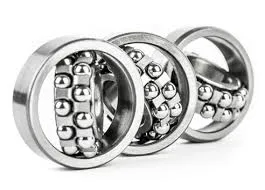
Nov . 09, 2024 03:32 Back to list
Tapered Roller Bearing Size Specifications and Dimension Reference Guide
Understanding Taper Roller Bearing Dimensions A Comprehensive Guide
Taper roller bearings are crucial components widely used in various applications, including automotive and industrial machinery. Their design allows them to handle significant radial and axial loads, making them suitable for heavy-duty operations. A key aspect to ensure the effective functionality of taper roller bearings is an understanding of their dimensions. In this article, we will explore the importance of taper roller bearing dimensions, the standard sizing chart, and how to choose the right bearing for your needs.
What are Taper Roller Bearings?
Taper roller bearings are a type of rolling-element bearing that consists of tapered rollers arranged between an inner ring and an outer ring. The design allows the rollers to make contact with the raceways at a specific angle, which helps in distributing loads effectively. This configuration provides excellent support for both axial and radial loads, making taper roller bearings ideal for applications where high capacity and durability are required.
Importance of Bearing Dimensions
When selecting a taper roller bearing, understanding its dimensions is paramount. The dimensions primarily include the outer diameter (O.D.), inner diameter (I.D.), width (B), and the taper angle. These dimensions are crucial for ensuring that the bearing fits correctly in its housing and operates within its load capacity.
1. Outer Diameter (O.D.) This dimension corresponds to the outside diameter of the outer ring. It is essential for ensuring proper fitting within the housing and impacts the overall size of the machinery.
2. Inner Diameter (I.D.) The inner diameter is crucial for the fit onto the shaft. It is vital that this dimension matches the shaft size accurately to prevent slippage or excessive wear.
3. Width (B) The width of the bearing affects the load-carrying capacity. Generally, a wider bearing can support higher loads but also requires more space in the machinery design.
4. Taper Angle The taper angle of the rollers affects how forces are distributed within the bearing. Different applications may require different angles to optimize load capacity and performance.
Standard Taper Roller Bearing Dimensions Chart
taper roller bearing dimensions chart

To assist engineers and mechanics in identifying the correct taper roller bearings, various manufacturers provide standardized dimensions which serve as a reference point. Here’s a typical dimensions chart you might encounter
| Item | Inner Diameter (mm) | Outer Diameter (mm) | Width (mm) | Load Rating (kN) | |------|---------------------|---------------------|-------------|-------------------| | 1 | 20 | 42 | 16 | 12.3 | | 2 | 25 | 52 | 16 | 16.5 | | 3 | 30 | 62 | 16 | 20.2 | | 4 | 35 | 72 | 20 | 30.1 | | 5 | 40 | 82 | 24 | 36.0 |
(Note The values provided in this chart are representative and may vary among manufacturers.)
Choosing the Right Taper Roller Bearing
Selecting the correct taper roller bearing involves several considerations
1. Load Requirements Understanding the operating loads—both axial and radial—is fundamental. Calculate the total load that the bearing will encounter in operation to ensure it falls within the bearing’s rated capacity.
2. Speed of Operation Consider the rotational speed of the application. Taper roller bearings are suitable for high-speed operations if appropriately sized and lubricated.
3. Environmental Factors Depending on the working environment (temperature, presence of debris, humidity), you may need bearings with specific sealing solutions or materials.
4. Installation Space Ensure that the dimensions of the taper roller bearing fit the designed assembly space in the machinery.
Conclusion
Taper roller bearings play a vital role in the performance and longevity of machinery. Understanding their dimensions is essential for proper selection and installation. By referring to standardized dimensions charts and considering the specific application requirements, you can choose the right taper roller bearings that will ensure optimal performance and durability in your operations. Properly selected and maintained, these bearings will enhance efficiency, reduce maintenance costs, and contribute to the overall reliability of the equipment.
Latest news
-
Spherical Roller Bearings Applications: Heavy Duty, Self-Aligning
NewsAug.30,2025
-
Premium Deep Groove Ball Bearings | High Speed & Reliability
NewsAug.29,2025
-
Durable Scaffolding Clamps - Secure & Reliable Tube Connectors
NewsAug.28,2025
-
Common Failures in Thrust Ball Bearings and Solutions
NewsAug.22,2025
-
How Tapered Roller Bearings Can Take Shock Loads
NewsAug.22,2025
-
Angular Bearings in High-Precision Spindles
NewsAug.22,2025
